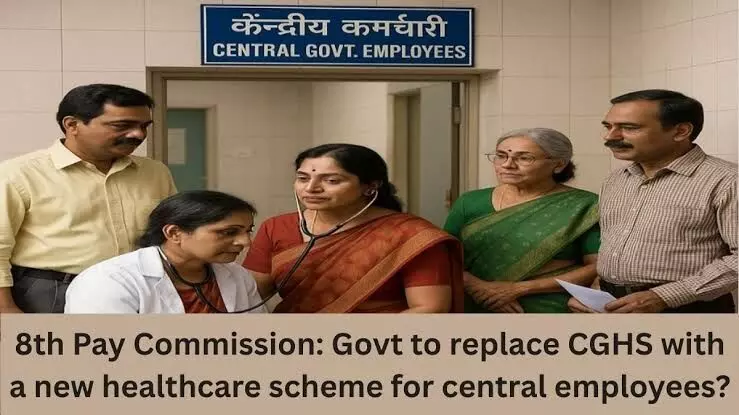Healthcare or Hidden Tax? The Unfolding Debate on Replacing CGHS Under the 8th Pay Commission

The proposal to replace the long-standing Central Government Health Scheme (CGHS) with a new healthcare initiative under the 8th Pay Commission has ignited a complex and polarizing debate. At the heart of this issue lies a critical question: is this an honest attempt to improve healthcare facilities for central government employees and pensioners, or a strategic revenue collection move disguised as reform? The answer is neither simple nor one-dimensional, as it involves dissecting the ground realities, data, policy intent, and the lived experiences of over 70 lakh employees and pensioners.
CGHS, which currently serves around 42 lakh beneficiaries across 80 cities, has long been criticized for its limited reach, overcrowded dispensaries, and bureaucratic inefficiencies. A large segment of central government employees working in rural and semi-urban areas remain excluded from its benefits. The 6th and 7th Pay Commissions highlighted this disparity, recommending the creation of an insurance-based, inclusive healthcare model that could extend quality medical services to all employees and retirees, regardless of geography. However, these recommendations have largely remained on paper, leaving the existing system stagnant and increasingly irrelevant for a substantial portion of its target population.
In this context, the introduction of a new healthcare scheme under the 8th Pay Commission could be seen as a much-needed correction. The idea of an insurance-backed, cashless system involving private hospitals has the potential to democratize healthcare access and address the persistent gaps CGHS has failed to fill for decades. An insurance model could empower employees to seek treatment in a wider network of hospitals, reducing dependence on the overburdened and often inefficient CGHS facilities. This would also be particularly significant for pensioners and employees living outside the current CGHS coverage areas, offering them a legitimate alternative to seek timely and quality medical care.
However, this seemingly progressive initiative has a critical flaw at its core — the proposal to make employee contributions mandatory. Historically, previous commissions suggested making insurance schemes optional, allowing individuals the freedom to opt-in based on personal healthcare needs and financial priorities. Making it compulsory changes the dynamic completely. Critics argue that this turns healthcare reform into a veiled method of additional revenue generation for the government. In a period where inflation and living costs are escalating, mandatory deductions would place yet another financial burden on employees, while guaranteeing no tangible improvements unless properly executed.
Public policy analyst Prof. Rajeev Sharma notes, “The real test lies in the implementation. Past pay commissions made promising recommendations, but none were comprehensively realized due to budgetary constraints and administrative inertia. Unless the government clearly defines coverage, empaneled hospitals, contribution rates, and grievance redressal mechanisms, this new scheme risks becoming another half-baked policy measure.” His concerns are rooted in historical precedent.
Despite the 7th Pay Commission's recommendations for empaneling hospitals for cashless treatment and extending benefits to pensioners outside CGHS areas, progress has been fragmented and inconsistent. Many pensioners report difficulties in availing cashless treatments and cite bureaucratic hurdles that diminish the practicality of such schemes.
Funding remains another critical concern. Healthcare reforms of this scale demand significant financial backing and robust administrative capacity. The government’s record on this front has been far from encouraging. Budget allocations for CGHS have stagnated over recent years, and without a clear fiscal roadmap, replacing CGHS with a comprehensive insurance-based system may remain an aspirational objective rather than an operational reality. Government insiders suggest that mandatory contributions could partially offset these costs, but doing so transfers the financial burden onto employees — effectively functioning as a hidden tax under the guise of healthcare reform.
The potential geopolitical and economic ripple effects are equally important, particularly for South Asian countries closely tied to India’s workforce and trade relations. Economists argue that increased financial strain on Indian government employees could suppress domestic consumption, indirectly affecting trade dynamics with neighboring countries dependent on Indian markets. Furthermore, if the scheme disproportionately benefits urban centers, it may widen the existing urban-rural healthcare divide, leading to socio-economic imbalances with regional repercussions.
On the ground, employees express skepticism and frustration. Sunil Kumar, a central government employee based in Patna, laments, “CGHS is practically non-existent for us. If the new scheme really ensures cashless treatment in reputed hospitals nearby, it would be good. But if it means more money deducted from our salaries without real facilities, it’s just exploitation.” His words reflect a broader sentiment of distrust born from years of unmet promises and piecemeal reforms.
Adding to this, health policy expert Dr. Anjali Mehra observes, “The government must remember that healthcare is not just a welfare service for employees — it directly impacts workforce productivity, morale, and social security. A poorly implemented scheme can have far-reaching consequences on public sector efficiency and employee satisfaction.” Dr. Mehra warns against hastily rolling out a scheme without thorough groundwork, pointing out that a top-heavy, contribution-driven model without corresponding infrastructural support would only add to employee grievances.
In essence, the debate over replacing CGHS under the 8th Pay Commission is far more than a policy shift; it embodies the ongoing struggle between fiscal pragmatism and employee welfare in India’s governance narrative. While the concept of healthcare reform is undeniably timely and necessary, the government’s track record, funding hesitations, and the lack of administrative preparedness cast a long shadow over its feasibility.
Unless the government strikes a judicious balance between mandatory contributions, comprehensive coverage, and transparent execution, this so-called healthcare initiative risks being perceived not as a welfare measure but as a clever revenue extraction tactic. For millions of employees and pensioners, this is not just a policy debate — it’s a question of financial security, dignity, and their basic right to accessible healthcare.
